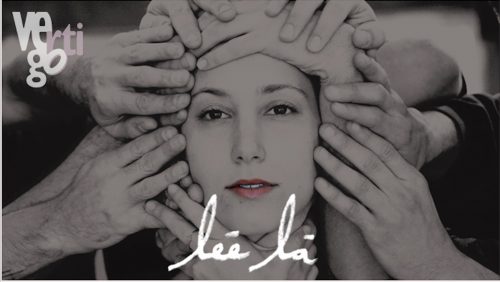


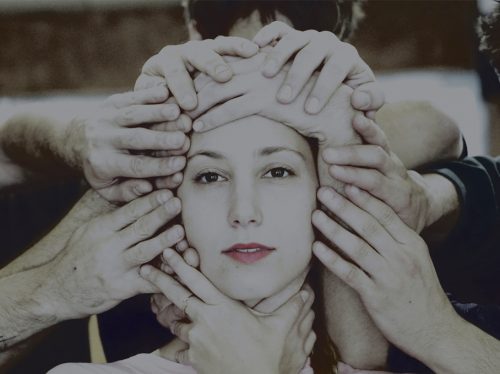
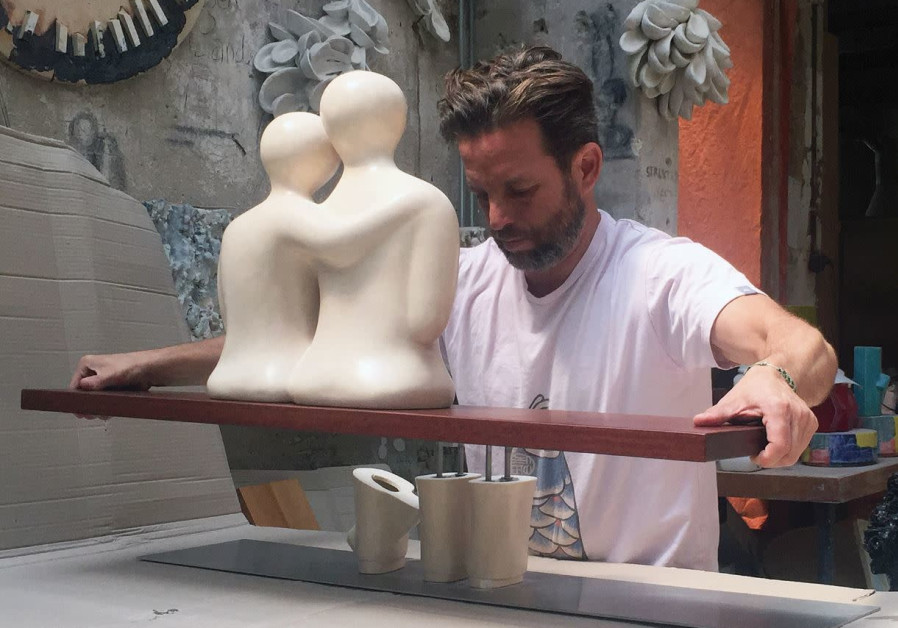
RAM KATZIR. (photo credit: YOAV DAGAN)
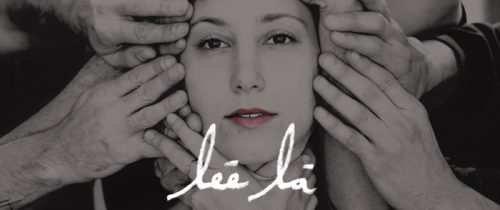
“Leela,” the new production from Vertigo Dance Company. (photo credit: RAM KATZIR)
Every choreographer will admit that each artistic creation bears its own impossible moments. The act of making art is intrinsically based on approaching the unknown, and most artists find themselves humbled by the myriad questions that a process can offer up.
On the afternoon that we spoke, Noa Wertheim was in such a moment. Just a few weeks away from the premiere of Vertigo Dance Company’s premiere of “Leela,” Wertheim was finding it hard to see the light at the end of her creative tunnel. There were glimmers but also a fair share of worries.
“It’s been a very difficult process,” she divulged. “I’m in the very hard moments right now. I’m on the edge of losing my mind.”
Wertheim is an old hand at exactly the type of insanity that was troubling her. After countless creations, running a leading Israeli troupe and establishing an ecological dance village, Wertheim knows how to take the good with the bad. She won’t sugarcoat her experiences, but she’s not too thrown by them either.
“We had our first few runs of the piece last week. I started to feel the heartbeat of the piece, and I started to smile again,” she laughed.
“Leela” is the newest to join the repertoire of Vertigo Dance Company, a list that includes “Birth of the Phoenix,” “White Noise,” “Mana” and many other works.
In Sanskrit, “Leela” means “a cosmic game.” It is the play between reality and God’s will.
“We started the creation a year ago, working on and off when there was time,” Wertheim said. “For the past two months, we’ve been a laboratory mode in the studio. Now we are at the end of it. I wanted some lightness. I felt that if I really looked at all the heaviness of the world around me, I would jump off of a peak. So I asked myself, ‘How do I treat this world with lightness? How do I play?’”
Wertheim brought this concept of play to her dancers and collaborators, as well as the idea of the space between Heaven and the real world.
“Ram Katzir, who is an incredible Israeli artist, designed the space. He created this huge set. It plays a huge part in the work. The stage has several layers, which goes along with the idea of the bigger picture,” she said.
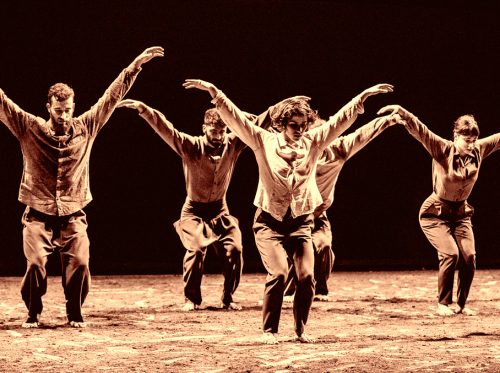
| Hagar Shachal and Shani Licht. Photo: Stephanie Berger |
Vertigo Dance Company had a two-night run at Baryshnikov Arts Center on Mar 5 & 6. It’s a shame it wasn’t longer so more New Yorkers could have had a chance to catch its wonderful piece, One. One & One. This Israeli company, led by Noa Wertheim, further burnishes the country’s reputation for producing notable choreographers. And while each one furthers her/his own individual style, there seems to be a physicality, sensuality, and interpersonal connection in common.
At the start of One, a man pours dirt in lines across the stage as Shani Licht stands and begins to undulate and bend backward, her long hair grazing the floor. Three men approach her, divide her tresses in three, and by crossing over and under one another, braid her hair. Eventually all 10 dancers enter, and each struts downstage and throws the audience a look. Here, the varying score by Avi Belleli crescendoes into loud rock section as the dancers move with more urgency and violence. More dirt is spread. The first woman is joined by another; they face each other separated by only inches, and move in symmetry, highly sensitive and in tune. A woman charges across the stage at a man, flinging herself at him; this repeats. They slap their chests, legs bent deeply, summoning images of gorillas asserting themselves.
In groups of four, they soften their movement, sweeping their legs in circles in the now pervasive dirt, as the sound of muffled blasts combines with plangent guitar, evoking—as does the dance—violence and beauty. They ripple their bodies, energy phasing from head to toe; a woman runs figure 8s around her curves. They run backward, bent forward, arms flung up and out like a diving cormorant. Music that might accompany a line dance at a party accompanies big chassees, spins, and deep plies; one man is carried aloft by three mates as if seated. Hagar Shachal goads the men, lunging at them as if suddenly provoked, and they begin to chase her as she evades their grasp. They finally catch her and subdue her, pinning her down until she subsides fully.
| Vertigo Dance Company in One. One & One. Photo: Stephanie Berger |
A solo by Etai Peri features effortless, silky, upright movement, legs floating high, and a rippling torso. The dancers often evoke animals, moving individually, but sometimes en mass, communicating wordlessly and with physical cues. One man remains lying on the dirt as the group moves ensemble, beating their chests and leaping like frogs; the loner grabs one man’s ankles as if to beg for a savior. The music swells like an orchestral film score, punctuated by twinkling keyboard notes. As the lights dim, the dancers recede, flapping their arms slowly.
Wertheim also established the Vertigo Eco-Art Village in Israel, a learning center that promotes sustainable, eco-friendly practices. This attention to one’s surroundings and a heightened awareness and appreciation of the environment perhaps informs Wertheim’s movement and the company members’ interactions.


Watching nine members of Israel’s Jerusalem-based Vertigo Dance Company perform One. One & One at the Baryshnikov Arts Center, you don’t think of green pastures and rippling brooks, you imagine rocky or sandy terrain being dug into and turned over and wrestled into fertility. Soil itself figures in this dance by Noa Wertheim, with Rina Wertheim-Koren as a co-creator. To sounds of rumbling, of thunder, of shovels at work, one man (Daniel Costa) backs across the front of the stage, carefully spilling a line of red-brown earth from a large bucket. Eventually, two additional lines of dirt will be laid down; later still, people rush around the stage, hurling more dirt from pails as they go.
When the members of this community dance, their feet trace circles and arcs and tangles in the increasingly mottled surface of their terrain. Since the choreography pushes them from jumping and striding into falling to the floor and rising again, their shirts and pants (by Sasson Kedem), their hair, and their faces become pocked with earth. This deters them not a whit. The soil even becomes part of a conversation: at some point, as Korina Fraiman and Costa approach each other slowly, one, then the other, throws a small handful of dirt at—yet somehow not at—his/her opposite; they end in a hug.

A remarkable solo by Shani Licht at the beginning of One. One & One alerts us to how these people move and think. She dances slowly and forcefully, as if she’s shaping her world, or perhaps being shaped by it. She arches back so far that you imagine her being pressed down. Her feet are often planted wide apart, her knees bent, yet her legs may twist around each other or kick out, her hips swing (but not enticingly). This is dance as work, but also as dreaming (some of her movements will reappear later, performed by others in other contexts). When three men lift her, set her down, lift her, and set her down elsewhere, they don’t look like furniture movers, but as if they’re trying to understand her. As she advances carefully, they follow her closely, ducking under and passing over one another as together they braid her long hair.
Roy Vatury’s set design abets the image of community. A long bench stretches along either side of the stage, and people often sit on these to watch what their colleagues are doing. The lighting by Dani Fishof – Magenta occasionally alters their world (say by projecting a checkerboard of squares on the floor), but the score composed by Avi Belleli enhances Wertheim’s choreography in quite particular ways—creating noises of chaos, gentling down, turning sweet, calling out, muttering, whistling, falling silent. At times, it provides a lively beat to manage the dancers into unison.
We come to know the choreography’s codes, if not always certain what they conceal. Whether moving in unison or individually, we see the dancers shake their hands vigorously, caress their heads, frantically gather in invisible substances, throw their arms high, slap and brush their thighs as if to rid themselves of dirt. But we’re not invited to consider anything as pantomimic. All these gestures, rhythmic and exact, are combined with forceful footwork, canted leaps, spins, big spraddle-legged jumps, and falls to the floor. At moments, you can see a hint of a folk dance, re-imagined.

There are mysteries. Licht and Hagar Schachal, standing close together and facing each other, might be fighting, but they’re not. They circle one another, lock together, almost butt chests, draw back, and lean in. Yet their duet looks non-combative, almost experimental, almost pensive. In a later sequence, Schachal has been dancing, bending into that back arch, watched by five others (Jeremy Alberge, Yotam Baruch, Sándor Petrovics, Etai Peri, and, as I remember, Liel Fibak). When they begin rushing around, you sense that they are following her, wanting to help her; she doesn’t seem to feel chased. However, when they catch her and lift her lying flat and prone, you become uncertain. They run with her this way, put her down, pick her up again, travel elsewhere. Finally, all five pin her down by lying over her; she tries unsuccessfully to get away, but they roll her to a corner and, finally, out of sight.

When Fibak dances close to the audience in the Baryshnikov’s black-box Jerome Robbins Theater, you notice that her gray shirt gets pulled up by her motions, and that she’s unconcerned about that. Some of the solos that erupt like hers make the dancers appear to be buffeted by strong winds or toppled by unseen forces. Yet they weather all these storms, the women as strong as the men. Continuing a sequence in which the women charge erratically across the stage, each launching herself onto one of the waiting men, Korina Fraiman not only jumps onto Petrovics many times, she ends up with him draped over her shoulder and carries him offstage. She is the smallest of the women; he is the tallest of the men.
The movement may be fierce but the dancers’ concern for one another is constant. Those who come and go on the benches seem always ready to join or intervene. At the end of the piece, when Licht and (as I recall) Petrovics are clinging together and leaning apart, and a cello is singing sweetly, the others stand in place, their arms spreading like wings—would-be angels flying nowhere. Finally, as the music dwindles into sustained tones and a high held note, one man just sits quietly, watching an empty stage as the lights dim.
This powerful piece of Wertheim’s conveys a desire for unity in a dangerously fragmenting world, whether that “world” is an exterior landscape or an interior one. Or both.

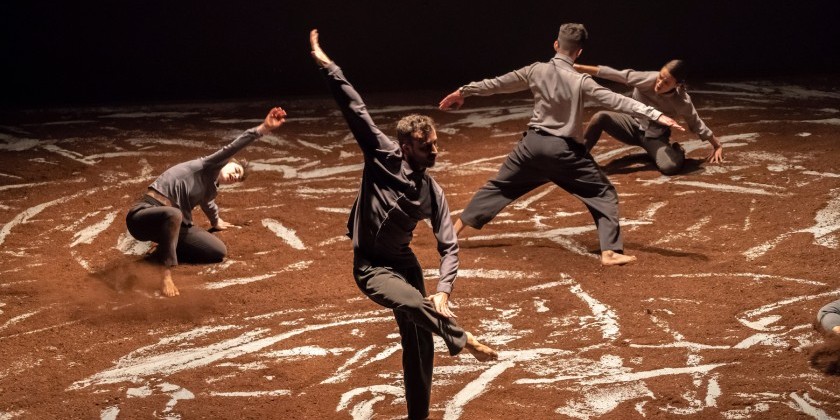
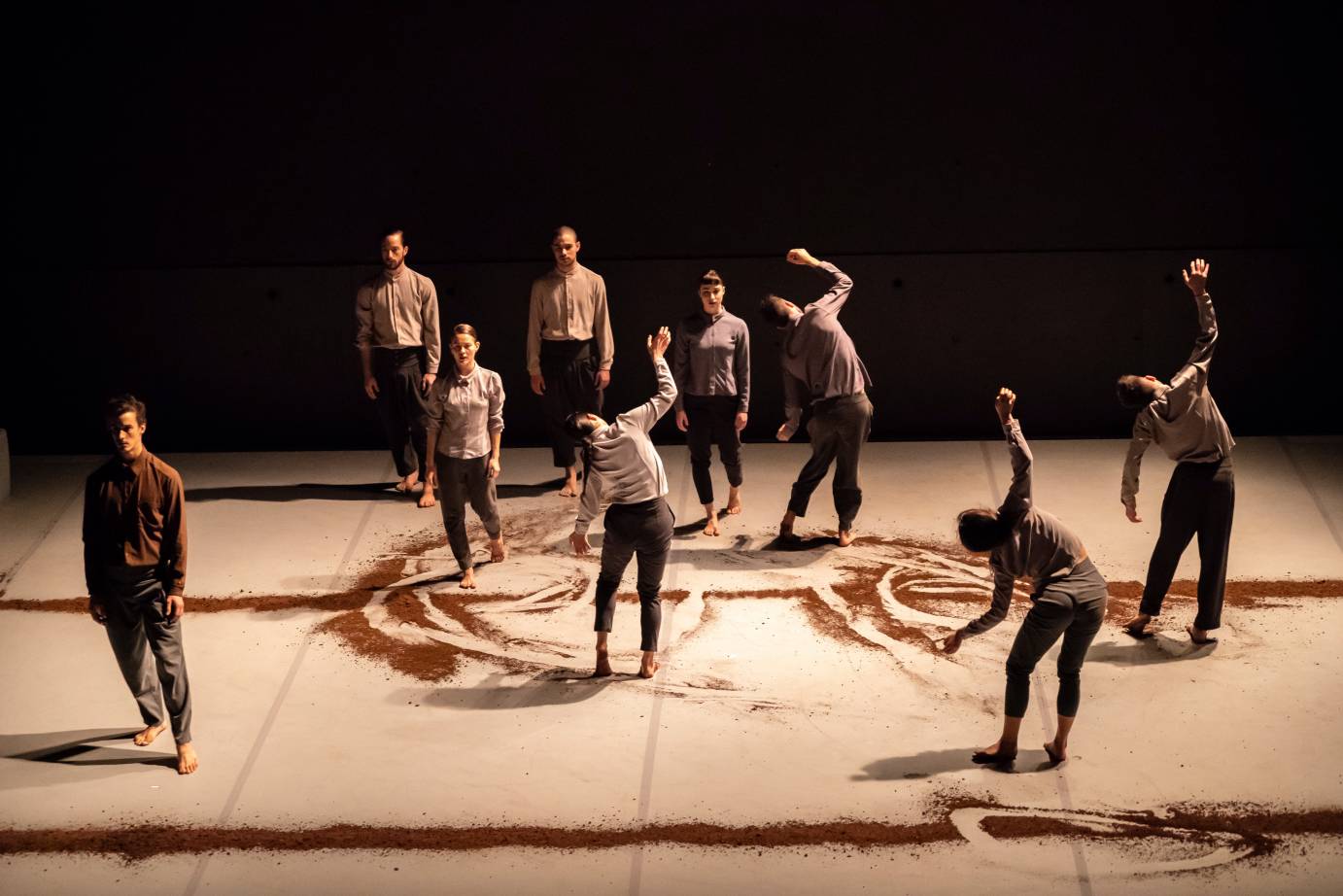
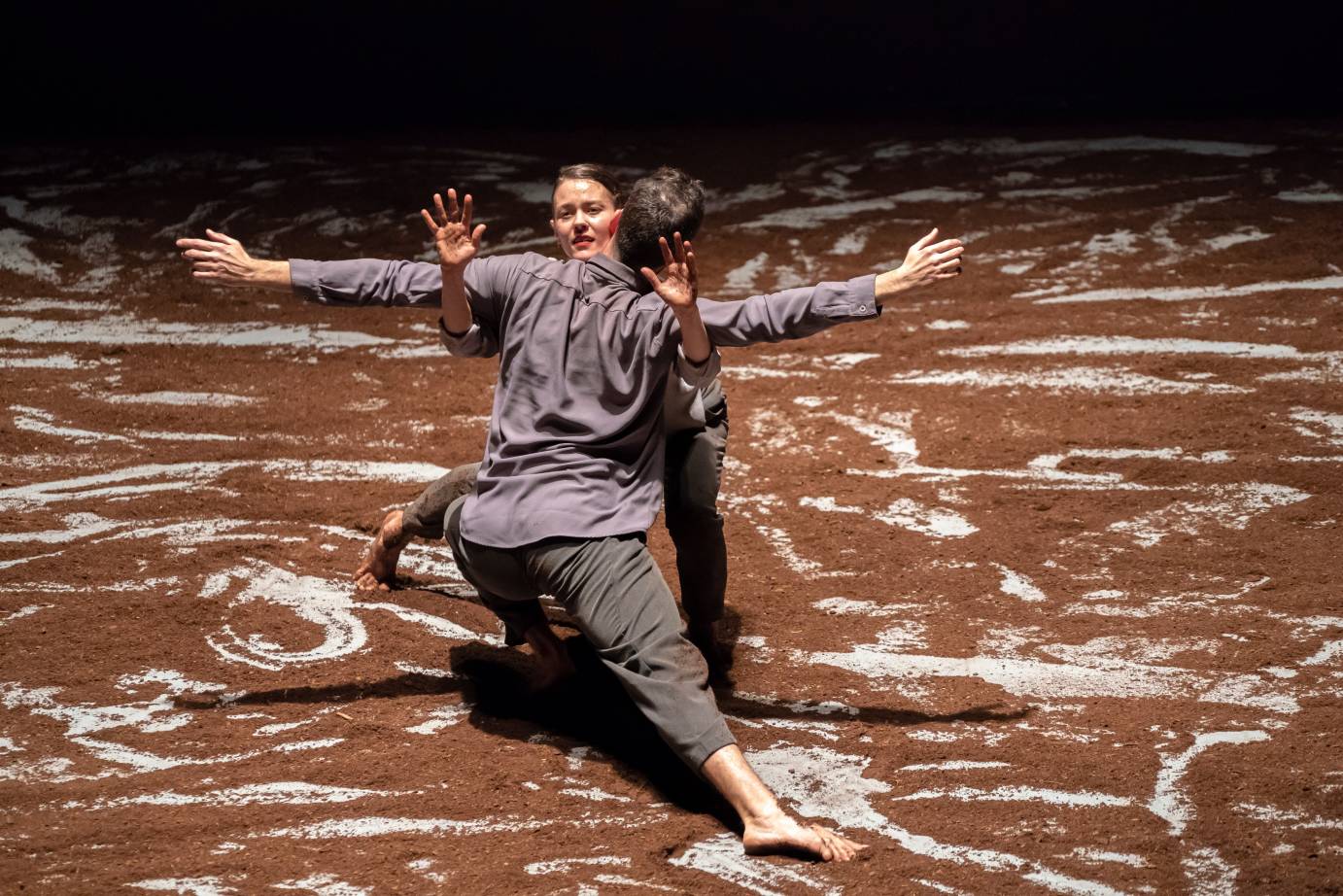

“One. One & One”
Vertigo Dance Company
Baryshnikov Arts Center, New York
March 6, 2019
by Tom Phillips
copyright 2019 by Tom Phillips
Except for a neat row of dirt at the front of the stage, the opening section of “One. One & One” by Israel’s Vertigo Dance Company looks much like the closing elegy of George Balanchine’s “Serenade.” It’s a solemn communal idyll, to sonorous cellos in a minor key, with a motif of dancers leaning on each other for balance and support. They seem to be a close-knit group, working out complex tasks together –- as when three men braid the hair of a woman while she uses her long tresses to pull them across the stage.
Photo by Stephanie Berger.
The communal spirit stays as more dirt is spread in the rectangular, closed space. But the mood changes suddenly with the sound of a cannonade — big guns, firing in the distance. After that, the dirt and the dancers start to fly, and the communal idyll is transformed into what looks like an army boot camp, whipping troops into combat readiness. The motif here is “bring it on,” with dancers lining up on each side of the stage and charging at their opposite numbers, trying to breach their defenses. Every charge is repelled!So much for “Serenade.” This looks more like Socialist Realism, the kind of state-sponsored art that Balanchine came to America to get away from. And if it reminds you of the modern history of Israel, as seen by the State of Israel, that’s just what it looked like to me.
Vertigo Dance Company is sponsored by The State of Israel. That’s not to say all is victory and light in “One. One & One.” The only drama comes late in the piece, when a woman seems to freak out over the demands of this regimen. She breaks for the non-existent exits, writhes and struggles, but is stopped and subdued at every turn by multiple mates, finally hauled off by the scruff of her shirt and guarded by a posse until she calms down. She’s back in formation for the closing elegy, with cellos deepening, still in that minor key.
The dancers deserve credit for grace, intensity and endurance, and choreographer Noa Wertheim’s combinations are inventive as well as athletic. But the world created by this dance is claustrophobic and completely one-sided. Danger and conflict are all around, but they never enter the space. Disembodied foes shoot guns in the distance; the response is to close ranks and work the troops into a frenzy. The dirt seems an obvious reference to the land of Israel, the object of turf wars since biblical times. The title evokes the presence of two nations on that holy ground, but the work shows only one. And what we see isn’t war, just endless readiness, mounting stress.
If that’s what it’s like in Israel today, I’d freak out too.
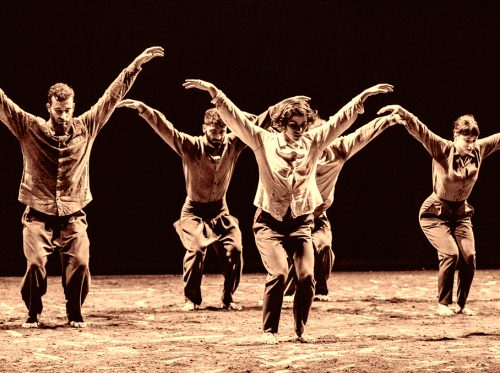
Imagine dancing in a large studio, with windows on two sides, mountains in the distance and flowers right up close. You take a shower outdoors with “grey water” that’s been collected from the roof and recycled into the plants. You use compost toilets to avoid using water in the desert and you might even stay overnight in a “mud room.”
This is Vertigo Dance Company‘s Eco-Art Village in the Elah Valley (where, in biblical times, David fought Goliath). It is not only a beautiful spot on earth but also a model of ecologically sustainable living and working. And a place where the company of fierce yet gentle dancers, create new work in the partly improvised approach guided by Wertheim.
This month, Vertigo’s One. One & One, a compelling 25th-anniversary production choreographed by artistic director Noa Wertheim, comes to the Baryshnikov Arts Center, DANCECleveland and the Clarice Smith Performing Arts Center at the University of Maryland, College Park.
I recently spoke with Wertheim about her work, and how it’s been shaped by the Eco-Art Village she runs with her extended family.
“This is very intimate, about feelings. To put feeling into movement is an interesting task. In Hebrew, the title One. One & One, describes oneness but also a separation between people. We are always defining ourselves. It seems like more and more the separation is also happening inside of ourselves. In one duet with two women, they are mirroring each other. It’s nice when people are similar, to show that our self can be understood through each other.”
“I love nature and am influenced by nature. The Eco-Art Village is trying to behave ecologically—saving water in the desert, collecting it from the roof in big buckets. We have a compost center for the kitchen and toilet, and after a few months, we get plenty of black earth, rich earth, from it. I felt that material, earth at its most condensed, should be in the piece.”

Noa Wertheim and her husband Adi Shaal
Elad Debi
“Two years ago, I got an image of a man walking with a bucket in a line, delineating, putting limits, making the separating. We are not endless. Maybe our soul is endless but the body is not. We are moving beyond the edges even though we are stuck inside of it.
The first time I used earth onstage, 14 years ago, it was outdoors and I got really connected to ecology. I understood how we are behaving to the planet, raping our own land, the poison we put in. Then we started with the Eco-Art Village. It’s all connected. The choreography I’m creating always has conflict or dilemma. Even in nature, the lion eats the sheep or deer. One is taking from another in order to survive. Human beings always have strong feelings, willpower, conflicts.”
“My mom passed away 17 years ago. We are four sisters, four husbands and babies—altogether a tribe of 13. After one year, Adi, my husband and the father our three children, said, “When you four sisters are together, something is complete.” Then we started thinking about it. We came to this Kibbutz. Every night for a few years, like pioneers in the beginning of the country, we sat, asking what will be the essence of the place. We started putting these ideas into action, like turning the chicken coop into a dance studio. Now it’s growing. This year we are building a third studio.”

Rune Abro
“The dancers train in contact improvisation and release technique, with ballet once or twice a week. We do a little bit of centering, using the energy of martial arts. Our studio in Jerusalem is the school for studying the Vertigo language. It’s very versatile, what we give them. It takes some time for the dancers to go deep.
“You have to fall in love with your dancers. I mostly have Israeli dancers, but I like sometimes two or three from different countries. Israelis understand their roots, but it’s beautiful to have more flavors. Sometime Europeans are more patient. Of our nine dancers, one is from Hungary, one from Portugal and one from France.”
“I don’t bring the music that came to Israel 50 years ago. The togetherness of a nation can be joyful, but it can be also stepping on the other. Somebody is celebrating and somebody else is being stepped on. It’s an endless story.”
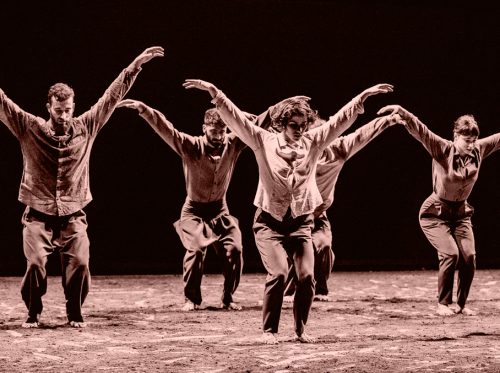
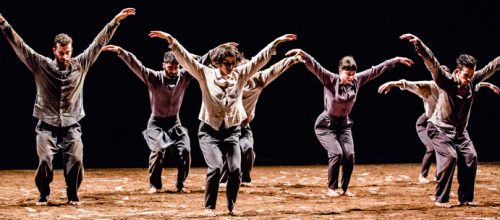

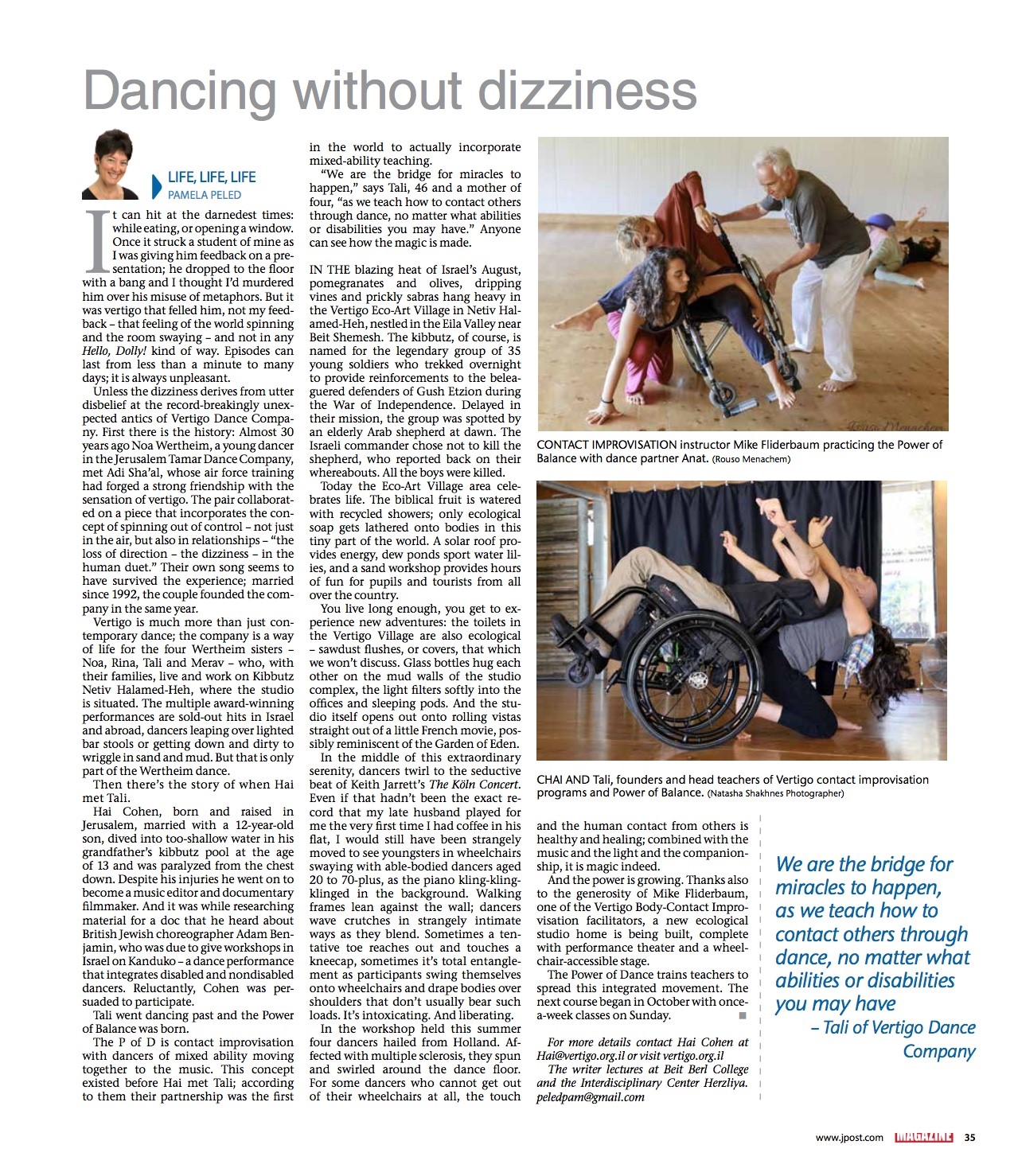
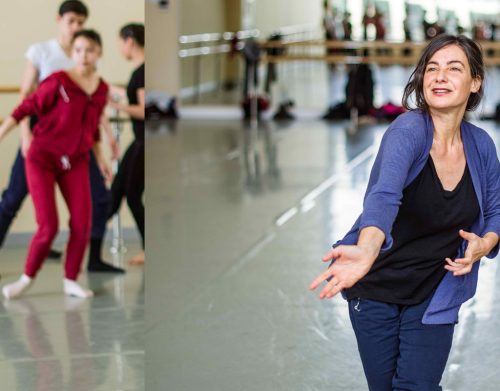
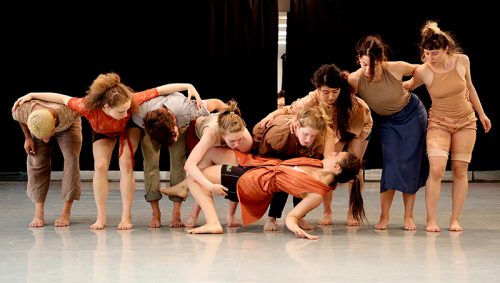
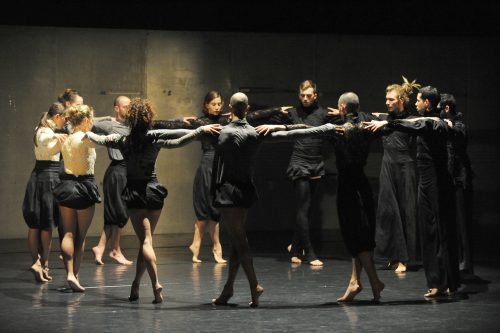
Balet. The Vertigo Dance Company from Jerusalem is showing the rousing piece “Vertigo 20” by choreographer Noa Wertheim. The piece premiered for the occasion of the 20th anniversary of the founding of the group.
During the beginning and the end floating balloons are hinting at a funfair situation, together with music that reminds you of barrel organs, which could be derived from a circus. But that doesn’t mean that we are actually at a funfair or a circus. Rather we are located in a realm of images and phantasy. In the one-hour sequence of scenes “Vertigo 20” everything is only indicated – and like this left to the imagination of the audience.
The performance is a Best-of-compilation of choreographies, elaborated by the Vertigo Dance Company in 20 years of their existence by Noa Wertheim and her partner Adi Sha’al, who founded the company in 1992. As a “Potpourri” it is surprisingly homogeneous and round, just the one or other alternation appears abruptly. On the one hand side Noa Wertheim invented an own dancing language for her company, which is based on the other hand on a philosophy of life in which the ecological awareness has an important role.
Quiet entry
It takes a certain time until which the versatile production takes the ride. Afterwards speedy and rapid scenes are changing with touching intimacy. In the first 20 minutes the young dancers – five women and six men – are moving rather calm and measured, interrupted by violent, cutting arm movements, that sometimes remind of puppets or when the dancers form a formation the military drill. Indeed Sha’al had the idea for the name “Vertigo” – dizziness – during his military training at the Israeli air force.
The soundtrack by Ran Bagno with elements of the waltz, march and techno, oriental elements and Israeli folk music, with accordion and drumbeats often acts archaic and suggests initiation rituals, which picks out the relationship between the single to the whole as a central theme. This impression is underlined by the stage set: it consists of three grey walls with small ledges: On them the dancers are sitting like sculptures, which are waiting to return to life. Also the black-and-white costumes (by Rakefet Levy, from whom is also the stage set) are ambiguous, which combine Victorian clothing and sports trousers; especially noticeable are the towering hairstyles of some of the female dancers – a fabulous idea. The play of the shadows on the walls are able to magnify the space and double the dance scenes (Light. Dani Fishof).
Hardly noticeable transitions
The magic of the performance results not least from the hardly noticeable transitions between the dancing pieces: from one moment to the other the images has changed, instead of a compact group, where the dancers act like mechanical puppets, occurs a circuit that increases into an overexcited runout: an enthralling, orgiastic celebration, a dance of the living. Close to the ending even slapstick elements and a smiling group image like in the silent film era can be found; it only lights up briefly, like an image out of a dream. Enchanting also the last scene, when floating, yellow glowing balloons are selected and single dancers with nearly unseen movements are stepp9ing into the front – this scene can be read as an allegory read on dance, which is nothing else than a dream under the conditio0ns of gravity, earthbound lightness.
Helmut Dworschak, in: Der Landbote, Sat. Oct. 7, 2017, p. 9
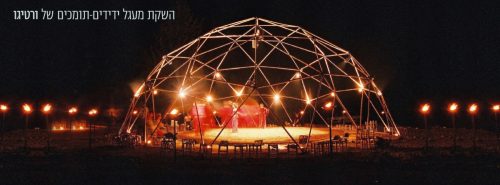
The new work composed by choreographer Noa Wertheim for the Vertigo Dance Company of Jerusalem had its premiere yesterday evening at the Karmiel Dance Festival.
Within the bamboo frame of a geodesic dome constructed in lush greenery, a lyric ceremony took place, wholly based on experiencing nature. Dancers were dancing on a circular surface of earth, and the audience surrounded them on all sides, sitting on wooden stools or on the ground. Weather, changes in lighting from day to night, and external rustling, presented the dancers of the Vertigo Dance Company with not an inconsiderable challenge. The audience, too, might be distracted now and then from the action on stage.
Wertheim’s point of departure in Birth of the Phoenix is the brown, sandy earth. A dancer scuttling on the ground sprouts and separates from it and then scatters in space. Alongside elements derived from the languages of Tai Chi and contact improvisation, Wertheim succeeds, with curved and fluid motion, in combining physicality and spirituality. Excellent Alex Shmurak makes her entrance to the ring with a movement that is expansive and confident. A whistle of wind is heard from time to time. A dripping drop is sometimes audible. Earth, wind, water and fire – all these elements are present in the original and eclectic music composed by Ran Bagno.
The dancers of Vertigo are used to the challenges presented to them regularly by Wertheim, and here, besides coping with natural surroundings and proximity to the audience, they are dancing on the bare earth. The result is astounding. Birth of the Phoenix is unique, rich and evolving. An extraordinary experience
(15:02, 14 JULY 2004)
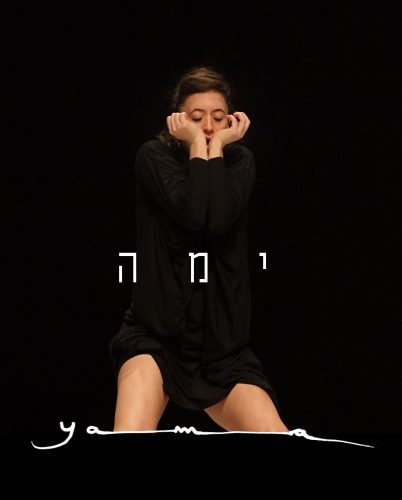
Ihr „Yama“, Ihre tänzerische See- und Tiefsee-Erkundungen haben in Geste und Bewegung mehr als
nur tief berührt. Für mich haben sie in Form und Ausdruck Spurenelemente einer „optimistischen
Tragödie“. So gesehen empfinde ich Ihre Choreografie wie eine bestechende Brechung und
Spiegelung, eines „Zwischenreiches“ von Menschen, die kaum noch freies Subjekt der Moderne und
ihrer Welt sind, sondern eher zu „Objekten“ der Macht der Verhältnisse geworden sind. Bedrängt,
belastet durch die Dinge, die Lasten, die Kuben, die über ihnen hängen und denen wir die Namen
Sachzwang, System, Struktur und Alternativlosigkeit geben, vom Terror und seinen grausamen
Feldzügen ganz abgesehen.
Als ich im Schlussbild die entblößte Frau, barfuß in freiester Bestimmtheit, entpanzert mit erhobenem
Arm ins „off“ abgehen sah, da empfand ich Sie und mich selbst wie Menschen, die nach all den
Lasten, nach all dem Unheil nur verschwinden wollen, sich vorher an der Tür noch einmal umdrehen,
weil Sie noch etwas sagen möchten, aber nichts mehr zu sagen haben, derweil der Rest der
Bekanntschaft sich weiter im rastlosen Kreise dreht. Alles auf Anfang.
Ich danke Ihnen für Ihre so bedrängende, aber ebenso befreiende Spiegelung unserer Befindlichkeit,
unseres Glücks und unserer freudlosen Verlorenheit, die uns nur zuflüstert nie nur uns selbst genug
zu sein, sondern sich in Gemeinschaft und Gemeinsamkeit jenseits von Ohnmacht und
Selbstbezogenheit der inneren Souveränität und Menschen-Zärtlichkeit zu versichern, ohne die eine
wirkliche Freiheit nie zu haben und zu leben ist.
Danke für diesen hinreißenden Abend voller Zorn, Zugeneigtheit und Melancholie, der uns im Inneren
Seekrank hinterlässt aber noch auf festem Boden
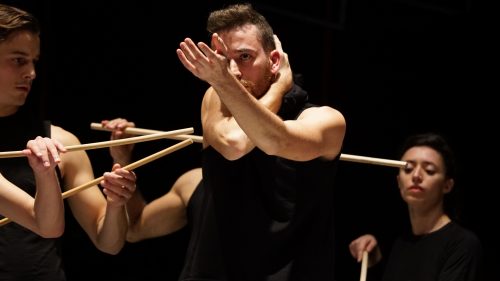
Noa wertheim talks a lot about the elements. “You are very air here and I need you to be more earth” is correction she has been known to giveto her dancers. When she speaks about fire,she isn’t only recognizing the positive elements but the potential dangerit possesses. “The same material can be soft and smooth and also strong and destructive,”says Wertheim over the phone.It is Sunday morning, and Wertheim ‘s dancers are just finish their warm-up, preparing for another intense day.The past few months have been busy for the members of Vertigo Dance Company. With new creation on the presses and multiple existing works being performed in Israel and abroad, they haven’t had much time to catch their breath. The new work, which will premiere next week, is study of the many faces of water. “I started research on Yama long time ago. started to look at movements that are at the extremes of the water spectrum.If water has no boundary, it will flow and flow. It keeps moving.On the other hand, if water is closed in on, it will explode in such powerful way that it can create tsunami,” she explain”s A.t the end of the day, there are very few things in the world that we don’t have any control over, and water isone of them.” The process, which beganlast year, saw significat unrtnover in the Vertigo cast. Where as Wertheim had grown accustomed to creat in aglongsid deancers who had been with her for several years, predominant new artists will perform Yama. “There was very challenging phase when tried to explore the movement material on group of my veteran dancers. Then, in September,had bigturn over of dancers. We had big tour. And then had to pass the material on to these new dancers. I’m used to working with dancers for five to eight years, Suddenly had change,and the oldest company member had been here for three years,s”he says In Yama, feel that was attracted to very deep cast. My new dancers are very deep, creative and ripe.The cast isvery strong,and enjoyit.It’s very special group,”she remarks. Wertheim explaints that the discovery of the material at hand occurred together with the discoveroy her cast. “Duringthe research, lot of things are revealed. It’s very interestingam. meeting the material and also the people at the same time. Like water, when you put person in corner, they can become monster,” she says. Another revelation that awaited Wertheim in the Yama journey came from her team of collaborators. Ran Bagno,who has worked with the company for more than 20 years, returned to write an original score for Yama. “It’s amazing to work with someone for so long and see that they can stil slurprise you,”she marvels. For costumes, Wertheim turned to fashion designer Sasson Kedem, whose black garbadds drama and volume to the movement. The set designer Swiss visual artist Nathalie Rodach, was the only new comer to the team. “Nathalie is doing the ater for the first time in her life.Several months ago she came to do residency at our ecologic vailllagien Kibbutz Netiv Halamed Hay. We got very close and had such great chemistry that we decided to work together on Yama. She went to the theater and measured, studied, learned the field. She did something very interestitng that really love,” she says. All the visual elements in Yama are black, fact that creates “local, Arabic, Middle Eastern” look to the work. “There is sense that something is being restrained on stage,that it is about to explode,”she says.
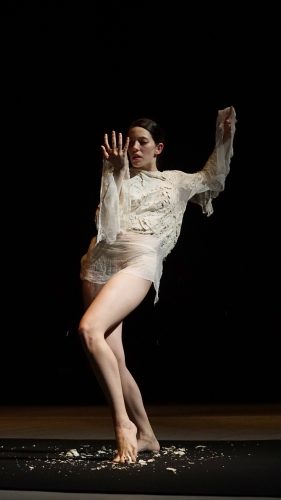
Noa Wertheimws new choreographique venture, Yama, is a amalgam of poetic mysticism, new-age spirituality and acute perceptiv enesofs space, allof which create pleasing beauty. This is true ot only for Yama but probably for most of Wertheim’s pieces. These elements have always been there, but as the years pass her craft gets more polished the seams tighter and the other stage components, particularly music (arranged for Yama by Ran Begano),lighting (design by Dani Fishof Magenta) and costumes (by designer Sasson Kedem) so cohesive it seems the entire team is geared toward preconceived aesthetic goal. Yet the work, as with any art form, would have been enriched by some subversive undercurrents. Yama opens with ceremonial entrance of dancers through line of black screens on both wings of the stage. Dressed in flowing black fabric,their exposed faces, arms and legg slow with warm light, and the movement is silky smooth, suggest in gritual. The mood is pensiveand rather somber. Later, itturns oppressivaes oversize geometric boxes hovering above descend slowly and stop four feet above the stage, meaning that each movement needs readjustment for the constrained space. The second appearance of the descending objects toward the end their presence ominous and dark actuall myoved the dramatic flow and allowed the dance to peak. One could see the constant effort to leave no loose ends and iron all the creases, yet one scene remained strange appendix, depicting six dancers holding long wooden sticks, poking victim in the center to death. lineof dances with sticks flooded my mind;from many ethnic dances to semi-theatrical ones by Sara Levi Tanai made for the old Inbal era, decades ago. Except that Yama didn’t build thematic or stylist conctext to justify this choice. In short, Yama is as beautiful as it comes from Vertigo productionsI. It didn’t rattleits safe zone much, but kepthigha esthetics, with one foot in spiritual spheres and the other planted strongly on earth. It enjoyed group of good dancers, particularthley new favorite:Ty Alexander Cheng, strongdancer of Afro-Chinese-Irish-Philippine descent
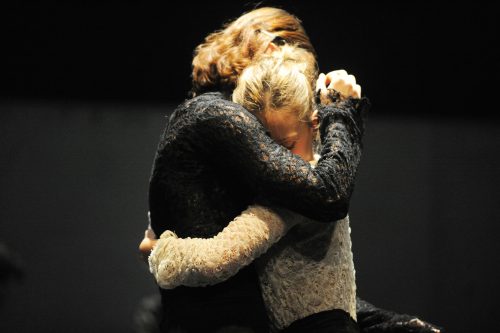
Even after the performance ended and the music and the lights went out, it seemed it was difficult to break away from thoughts of Yama, the dance performance produced by choreographer Noa Wertheim, artistic director of the Vertigo Dance Company. Charged with high level of emotional intelligence and a tendency towards aesthetic somberness, Wertheim sewed together a lyrical dance format capable of moving you to tears, an emotional experience etched deep in the mind. With every expression or movement; note in the composition; stitch and fold of the clothing; lighting, dimming or darkening; as well as each phase of movement and sound; and the whirl and flutter of costumes, all revealing an exciting and passionate artistic experience, bringing forward a performance and especially the content of a courageous work of art. Each aspect of this production is an art in itself, while the fabric of it all incorporating Wertheim’s dance language, the uplifting and virtuoso music of Ran Bagno, sculpture of the beautiful whirling costumes designed by Sasson Kedem, the striking lighting designed by Danny Fishof, and the dark stage paneled in black designed by Nathalie Rodach, creating a wonderful aesthetic harmony and adding to the intensive experience of this dance performance. However the content was left to be deciphered or imagined. “Description of content was left out of the printed program to allow individual interpretation and imagination,” said Adi Sha’al, Wertheim’s life partner, a dancer, CEO, cofounder, and co- artistic director of the Vertigo Dance Company. And all for the better for imagination with no barriers. Vertigo is more than a motion sensation, Vertigo dance company and performance reflect the vision of two young dancers whose paths have crossed on the dance stage. A meeting between Noa Wertheim and Adi Sha’al that weaved a love story, a creative duet, both personal and artistic. About 24 years have passed since they created their first duet naming it Vertigo, and since they founded a dance company under the same title based to this date at the Gerard Bechar Center in Jerusalem. Their life during those years have become an ongoing motion of activity, imagination and artistic creation while the Vertigo Dance Company performs in near and far destinations across the country and abroad becoming a leading modern dance troupe. Vertigo’s impressive repertoire depicts a dance style and language formulated by Wertheim, the artistic director, a collection of original works whose titles correspond with their complex journey through realms of dance and ideology. Each performance representing a chapter in the ideational life path of Noa and Adi and in the existence of the Vertigo Dance Company, incorporating artistic collaborations with dancers, choreographers and troupes from abroad. At one point, Wertheim and Sha’al began to look for a place, close to nature, where they can raise and educate their children in the spirit of a lifestyle they both aspired for. The ideal location was found in Kibbutz Netiv HaLamed Heh that welcomed them and their notion of establishing an integrated Arts center. Their Jerusalem base was never abandoned as they continue their work from both locations, however they chose to build their own home in the green landscape of the Ella valley. Nevertheless they did not move there alone, joined by Noa’s three sisters together with their spouses and children to create a family community lifestyle in this cultural and ecological oasis. Indeed, a unique residential village established to offer workshops and training to promote artistic dance in the light of community and spiritual awareness, and the ecological way of life. Rina, the youngest of Noa’s three sisters, a versatile and experienced dancer, is a principal dancer in the company and right hand to Wertheim in teaching the Vertigo distinct dance language. The other two sisters lead workshops at the center as well: Tally instructs the Power of Balance workshop supporting and guiding disabled participants through dance techniques based on contact improvisation, movement and listening; Merav, the eldest sister, leads a workshop that teaches the art of spiritual healing. Eventually, and for various accumulated reasons and factors, the Vertigo Eco-Art Village has become an established center attracting art and culture fans as well as local and international dancers and choreographers who come to explore the unique and educational experience, to collaborate with the company and participate in performances, workshops and artistic activities. I recently watched two dance pieces of choreographer Noa Wertheim performed by the Vertigo Dance Company, Vertigo 20 and Yama. An exciting experience and a challenging sheer pleasure that I cherish, inspiring though posing more questions than suggesting answers to highlight the dialogue between dance and perspective or movement and the visual and emotional expression. Vertigo20 is an artistic experience that evokes thoughts and reflections on the origin and nature of narratives and all that is told through the language of movement and choreography. I attempted to decipher the contents and although I was perhaps wrong, I enjoyed the freedom given to me to spread the wings of my imagination even if risking an error of interpretation due to my own impression. Indeed, I took the liberty to uninhibitedly imagine things to exist in places that are not necessarily obvious or even present. I imagined the weaving of relationships of love and hate, sensuality and rejection, reconciliation and violence, joy and sadness. Contrasts that I believe to be exposed through Wertheim’s solid dance pieces as she is engaged in surgery choreography, analyzing essences, the veins and arteries of movements and rhythms while sawing together notes and beats into a memorable experiential dance. Realizing that perhaps Wertheim can offer a more accurate insight of her intentions and creative vision I appreciated the opportunity given to me in between rehearsals to talk with her about dance, ecology, earth and nature, spirituality and roots, her life guidelines, arts and conventions. I met a special woman who leads a unique life in an extraordinary place. Our conversation, though offering some answers, has opened a great depth for questions and assumptions regarding her philosophy and the nature of the link between the art of dance and the ecological and spiritual experience characterizing Wertheim’s creative and communal conduct. Theatrical conventions usually imply content and text, a story or plot related to a certain time, period and place. Wertheim’s dance works are silent tales beginning with a single movement. Each movement representing a syllable, a sequence of movements forming silent motion words, phrases and contents. “I start with the material which I regard as the center of the body, bones and joints”, says Wertheim. “A dance begins with a single movement that is joined by another, structuring visual phrases and contents that make up the piece. After preliminary impressions are being formulated”, Wertheim says, “a creative discussion with costume designers, musicians and lighting designers begins”. In Vertigo 20, as well as previous works, Wertheim collaborated with costume and stage designer, Rakefet Levy. “Only after the syllables, words and phrases are selected, costumes are designed and the music is composed”, Wertheim notes. Levy succeeded, in a wonderful way, to weave a perfect fabric of contents, costumes and stage setting, while accentuating specific features such as the elegant appearance of the modern clothes and hints of humor and jest as appeared through costumes and sets to become integral artistic components of the show. “Vertigo 20 is a celebration of themes and principles accompanying us for over 20 years of creative work, a kind of retrospective of views and an observation of the essence of relations as a conscious choice or an act of coming into being”, emphasizes Wertheim. “Yama is a different show, burdensome and dark”, adds Wertheim that selected Sasson Kedem as the artistic costume designer. In fact Wertheim and Kedem are moving along the same line sharing the same spirit of creativity, Wertheim through her avant-garde movement language, and Kedem, one of the most original and revolutionary figure in local fashion scene, through his unique and innovative design language. These two artists cross-reference foreign artistic languages in this refined and precise creative merging and exquisite work of art, featuring a perfect correlation between the yet to be deciphered contents of Yama and the dramatic color of stage and clothes which are all painted black. Kedem links opposite extremes, avant-garde and the restrained, surreal and the practical, square sheets of fabric and rectangular, and triangles and circles, creating a quite incomprehensible artistically engineered tapestry. Generating motion in themselves, most striking garments correspond with body movements amplifying volumes and momentum of both costumes and dance. Can you mention someone from the dance scene that you are influenced by? “I appreciate the Modern Dance revolution led by Pina Bausch however I do not feel that I should aim to be like or identify with any character, artist, or creation. At different periods of time there may be some infiltrations echoing the subconscious imprints of previous experiences”. Wertheim does not apologize rather clarifying how through her creative work she relates to experiences and scenarios in her vicinity, things that happen in nature, in spirituality, ecology and our common responsibility to maintain world peace. How would you distinguish Yama? Yama is quite different in comparison with previous performances and choreographies, there is a different substance which is implied even through the music, costumes and stage setting, more significant and in control”, Wertheim concludes. And again for the better, especially in this case, allowing for individual interpretation of everything that happens and is shown in a courageous and forceful performance such as Yama. Indeed, it is quite understood that each of the artistic forces that make up the show have the right to exist independently while in the act , each complements and even enhances the presence of the other while joining together to form a strong creative non-competitive unit. “Noa is not a political choreographer but rather an experiential choreographer”, adds Eyal Vizner, former dancer of the Vertigo Dance Company and now the company’s director, following my meeting with Wertheim. “Every artist creates a world of its own. Our lives are like a closet with drawers, storing many things, and it does not matter which drawer was opened or what was our thought or intention while creating the dance, but what it stimulates in others”. Vizner is right, indeed Vertigo Dance Company’s performances stimulate and challenge you to dig deeper. After my experiential visit at the Vertigo Eco-Art Village in Kibbutz Netiv HaLamed Heh I also attended the premiere of Yama. I sat spellbind by all that was happening on the stage of the Vertigo dance theater that began with the thunderous opening sounds of war, the march of the drums and shooting that filled the space paneled in black sheets. A powerful opening that heralded, at least in my case and only in a nutshell, the impending excitement and drama, and a conclusion that is doubtfully optimistic. Perhaps in essence Wertheim is not a political choreographer, but the end result shows her being drawn into a reality restored through these dance fantasies. Therefore her tendency to depict the wind, nature and the earth, society and humanity as paving her conduct, requires her to carry the banner of protest to ensure their sustainability. In fact, implementing her total inner discipline and inherent poetic splendor, Wertheim has applied to the Vertigo contents and movement language some truths and beyond, what is visible and what may very well be discovered. Nowadays, when one cannot break away from the wave of political confrontation, what meaning other than political can be attributed to a performance like Yama? In Yama, Wertheim incorporates creative motifs that are intertwined throughout her rich repertoire, a journey that began with the duet performance of Vertigo marking the inauguration of her personal and creative life path with her partner, Adi Sha’al, and as expressed in other exciting duets. Stories that are told through spectacular gestures expressing encounters, conflicts and separations, longing and rejection, and even life and death, as can be implied by the duet depicting a male dancer carrying a helpless female dancer on his shoulders or by the weighty final scene. Another recurring theme in Wertheim’s dance is expressed through the circles – opening and closing life cycles flowing throughout their creative path and as a couple, as well as the traditional Israeli folk dance circles which seem to have a significant role in the blend. The selection of oriental music, the sound of drums echoing war, and the affinity to symbols borrowed from the local existence, sheds light on Wertheim’s sources of inspiration which apparently indicate that rather than confining herself to the artistic bubble she is indeed guided by everything that is going on around her. Another scene which to me seemed as pointing to an existing reality was the “dance of knives” in which dancers are carrying wooden poles as a symbol of the threat of terror (self-interpretation. NA). And alternatively throwing these wooden poles at what seemed like a prison wall or security fence. Other symbols of political confrontation were reflected through dancers raising their hands up and fingers marking the victory sign. The setting of black boxes as well, in my imagination resembles coffins, slowly descending from the ceiling as if threatening the space and therefore the existence of the dancers. To expand and deepen the conveyed message, Wertheim opts for a highly sensitive and painful finale, a Requiem played on the accordion by a dancer sitting on a “wave” of dancers, streaming, washing away and disappearing into the abyss. A pinch of optimism is detected in the “final dance” as the “professional weeper” on the accordion remove her black mourning dress and wears a white gown attached to her body with clay. Does Wertheim really try to conclude with a declaration of peace? Perhaps hope? Or maybe surrender? But that clay crumbles, the dress loosens and slides to the ground, leaving the naked dancer as she is walking into an unknown horizon. Have we really lost all hope? Wertheim leaves this question yet unanswered. The answer, as appeared in light of such an exquisite and pessimistic production, shall probably remain within the private reservoirs of hope.
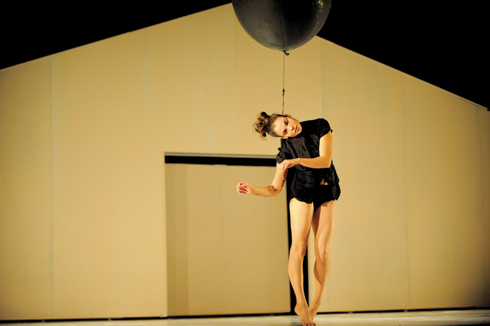
White Bird’s growing roster of exceptional Israeli modern dance companies has a new heavy hitter. The North American premiere of Vertigo Dance Company’s “Mana, Vessel of Light” is an hour-long study in duality – masculine and feminine, interior and exterior, forceful angularity against spiraling ritualism – choreographed by artistic director Noa Wertheim and arrestingly danced by her eight-member ensemble.
Wertheim’s title draws from the shattering of the primordial light depicted in the Zohar, the ancient text of Jewish mysticism, and early on, the earthy tribalism of the ensemble in unison suggests ceremonial surrender and physical transcendence. That religious subtext quickly fades. Wertheim is very much of the modern Israeli dance aesthetic; there’s a shared sensibility with the rich theatricality of Barak Marshall, the ecstatic ritualism of Ohad Naharin, the florid surrealism of Inbal Pinto. Like those powerhouses, Vertigo marries sharp abstraction to mind-teasing, sophisticated stage design.
The barest sketch of a house, like a child’s simplistic drawing, looms at the back of the stage. Over the course of the dance, it becomes animate, advancing and turning and receding, a mute and imposing framework into which dancers dissolve and then reappear. But it’s the dance, not the set, that holds the eye, at least until its jarring finale.
“Mana” begins with a single male dancer in layers of monk-like robes, feet firmly planted on the darkened stage, folding and slashing his arms in frantic cycles, fists to the sky. A kneeling onlooker, also robed, rises to join him, building an ecstatic rhythm in rocking sideways steps. Ran Bagno’s hypnotic score seems to float in the distance. The pair are a flurry of motion and stillness, extreme leans and backbends on the floor, so riveting that it’s startling to notice the door of the house has opened to reveal dancers meditatively walking interior passageways.
There’s an ecclesiastical solemnity to the growing cluster of dancers, clad in the long dark folds of Rakefet Levy’s exquisite costumes, circling, bending and stretching in silent unison. Palms out, snaking their bodies into curving crouches, the dancers’ movements seem to pulse as one collective organism. Unison is rarely this compelling on the modern dance stage, and Wertheim punctuates it with splinters of opposition flicking out in small gestures, gradually building to fervent spirals, barreling leaps and partners flipping over shoulders, adrenaline-fueled pure form circling back into an earthy vernacular.
“Mana” takes a turn to the surreal with the appearance of Rina Wertheim-Koren (Noa Wertheim’s younger sister) as a mechanical doll on tiptoes, her shoulders tethered to a black helium balloon. Against the shrouded ensemble, she’s all skin, long legs prancing and scissoring out, barely appearing to touch the stage.
From there, “Mana” evolves into an uneven juxtaposition of sacrament and martial arts, stylized sparring and sharp thrust and recoil against social dance and contact-improv manipulations. At its worst, it becomes an exaggerated, unoriginal take on gender wars, relegating the women to defiant or clinging foils against the militaristic kicking and stepping of the men.
By the end of the dance, the score has gone from meditative lullaby to hallucinatory carnival to rave-like electronica, and the choreography from abstract ritual to vamping dance club attitude. There’s not a weak link among the dancers in terms of technique, but as a culmination of intriguing ideas, it’s woefully anticlimactic. Just a hint of the old-time score trickles in to the clubhouse atmosphere, a time warp to when the unison of the dance seemed to be saying something more universal, more powerful than movement for movement’s sake.
